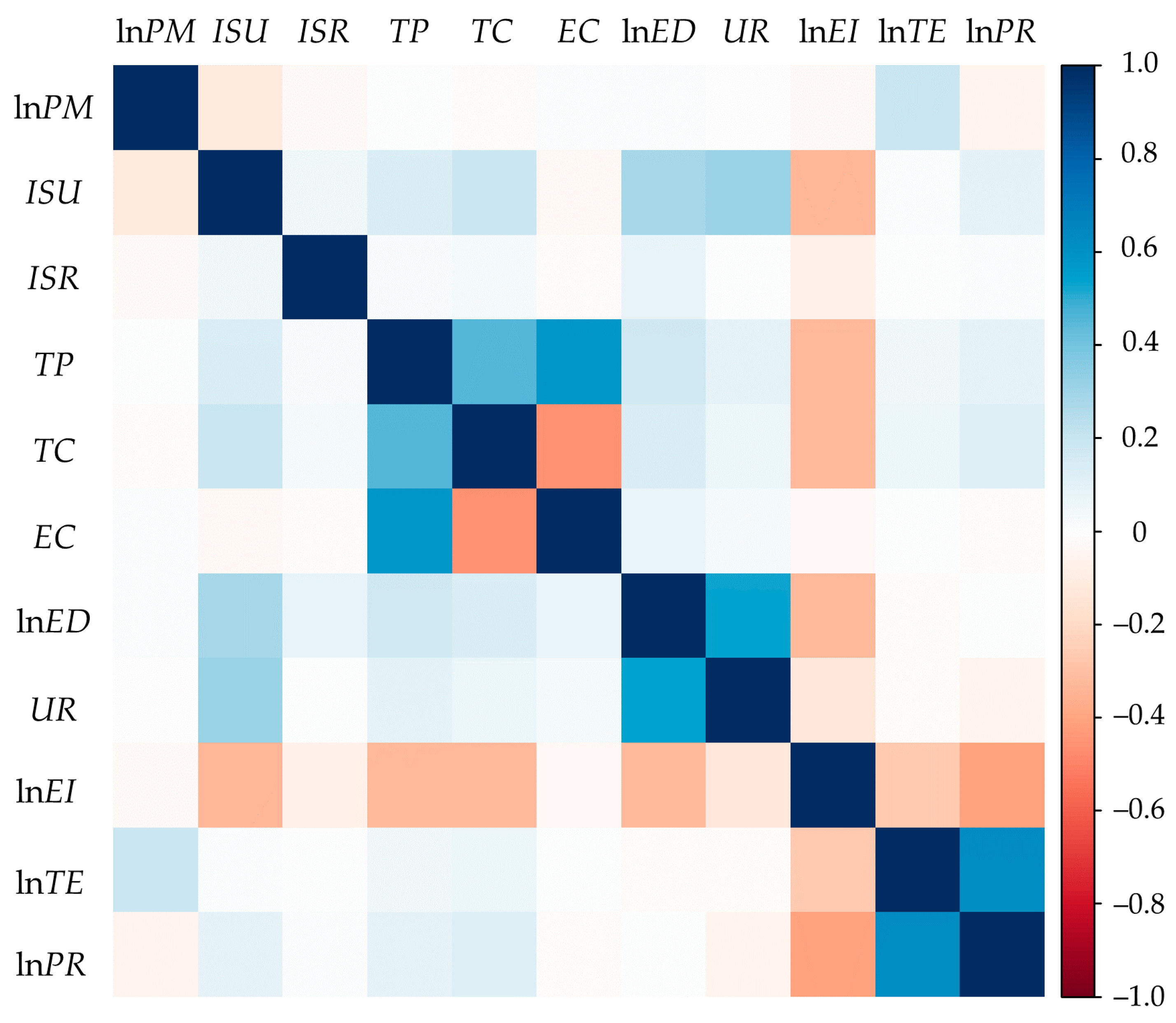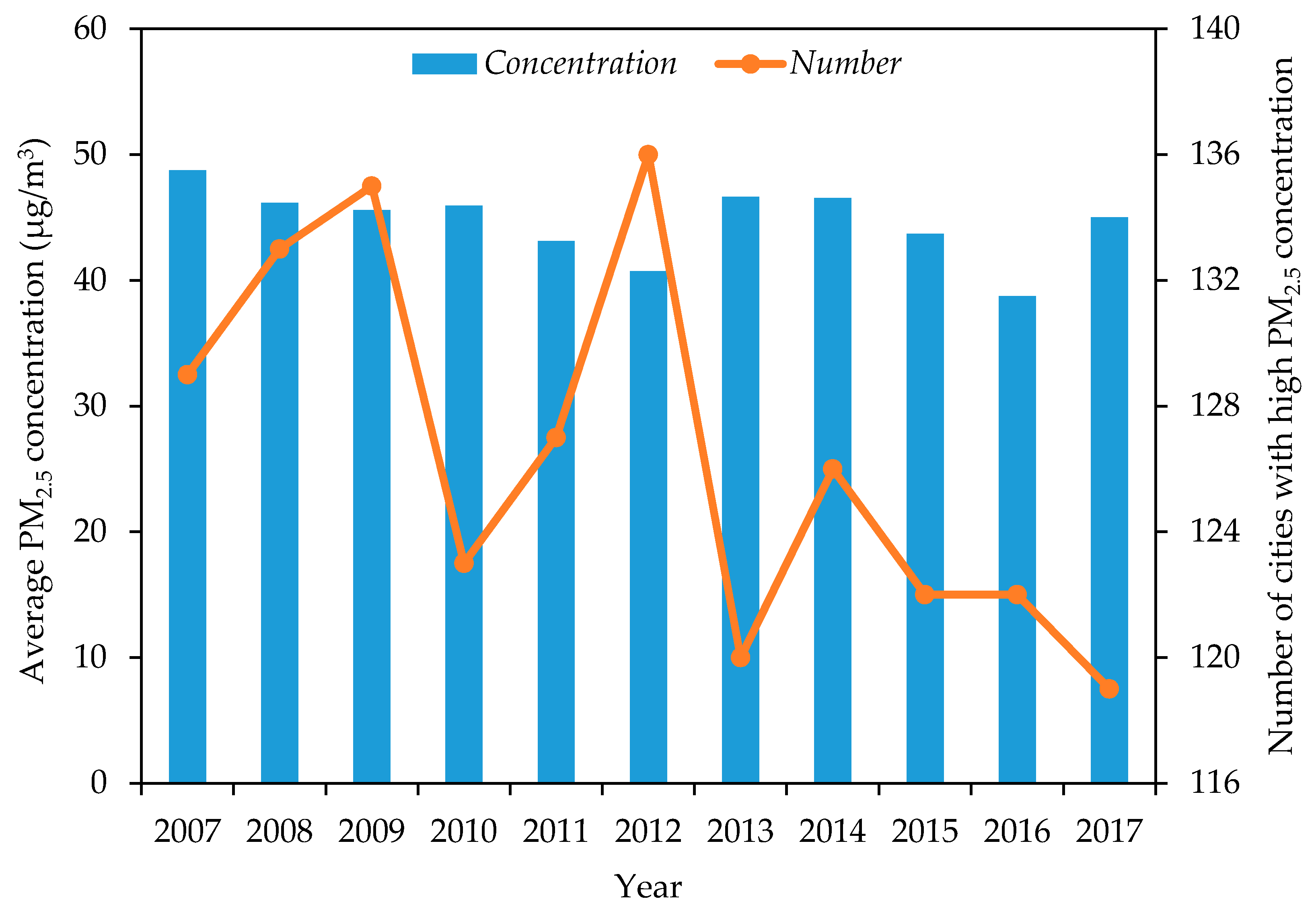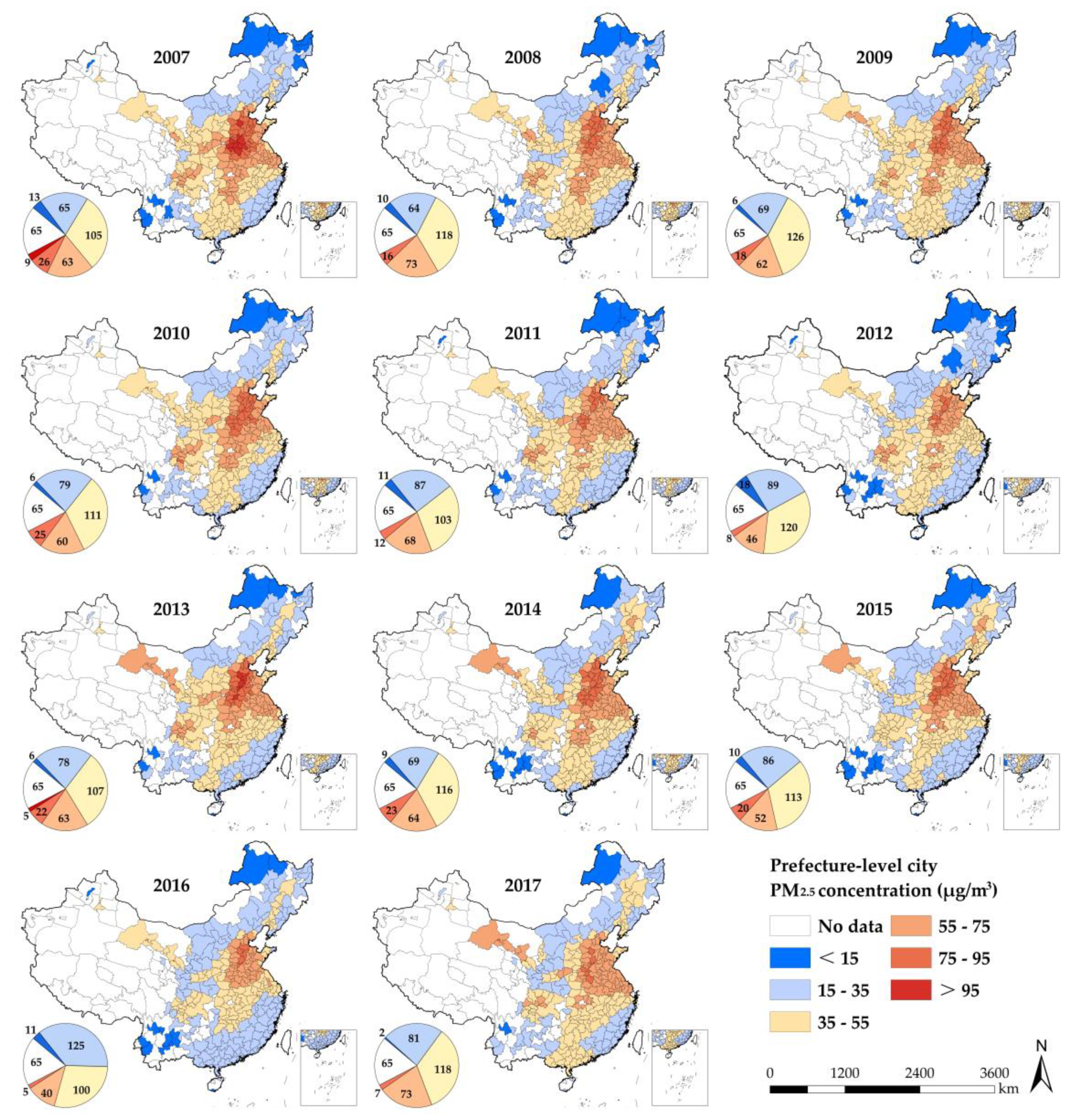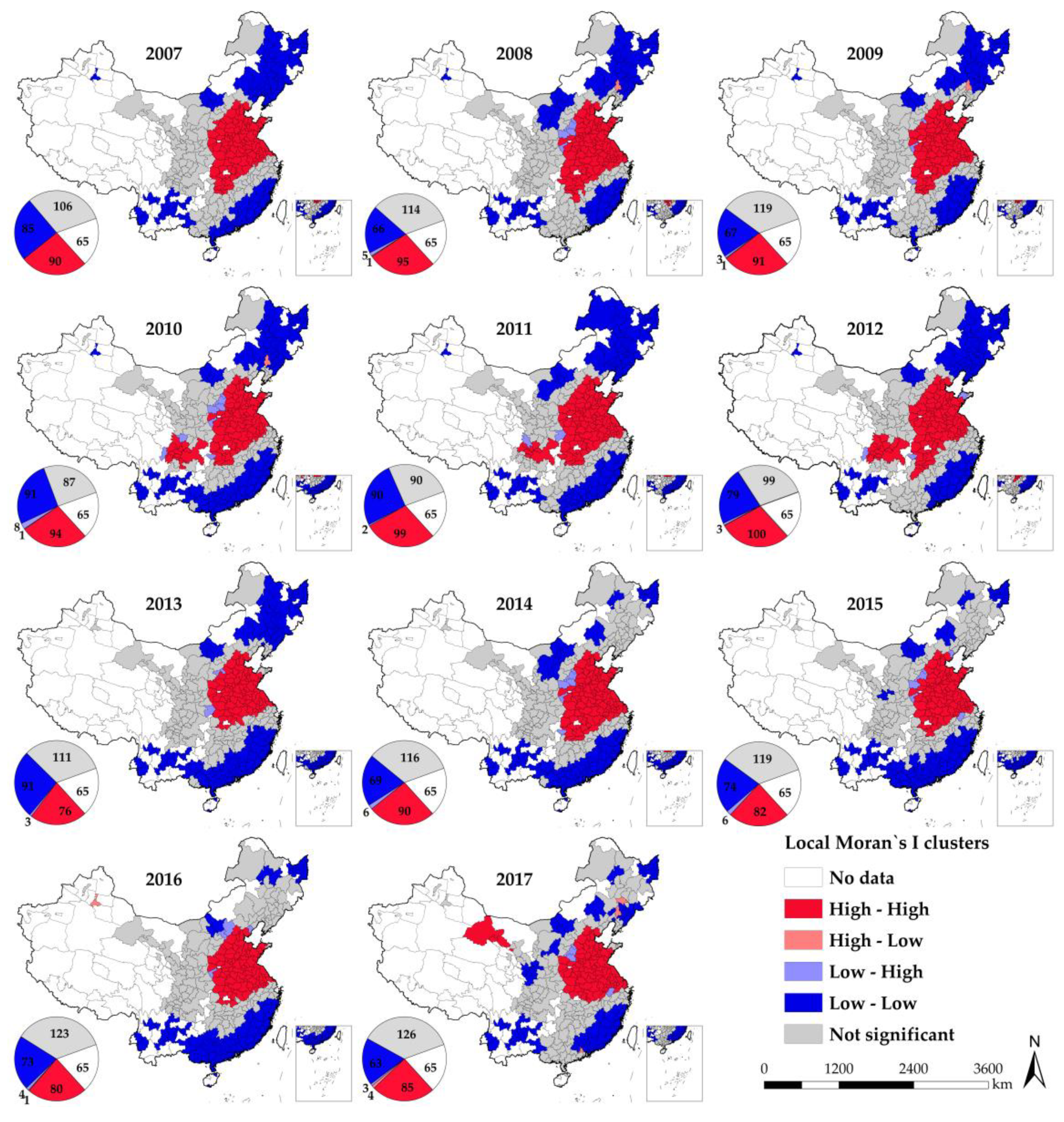Impacts of Industrial Restructuring and Technological Progress on PM2.5 Pollution: Evidence from Prefecture-Level Cities in China
Abstract
1. Introduction
2. Methodology and Materials
2.1. Model Derivation
2.2. Variables Description and Data
2.2.1. Core Explanatory Variables
- (1)
- Industrial structural upgrading (ISU): The international community usually divides various industries into three categories. This paper takes the proportion of the added value of the tertiary industry as the indicator of the upgrading of the industrial structure [33].
- (2)
- Industrial structure rationalization (ISR): Theil introduced the concept of entropy in information theory into economics, and used it to measure income inequality, which better reflects the uneven distribution of income factors in regions [34]. Therefore, the Theil index can be used to evaluate the rationalization of the industrial structure. The calculation method of Theil index is as follows:
- (3)
- Technological progress (TP): This paper takes the change of total factor productivity (TFPCH) as the indicator of TP. Because there is no need to estimate parameters in advance, data envelopment analysis (DEA) can effectively reduce errors and avoid the influence of subjective factors, and is suitable for evaluating the relative effectiveness of multi-input decision-making units [35]. Therefore, DEA-Malmquist productivity index method is used to calculate the TFPCH. At the same time, this method can further decompose TFPCH into technical change (TC) and efficiency change (EC) [36]. All the calculation work is based on the index database with the time span from 2006 to 2017 and DEAP 2.1 platform. The input indicators set in this paper include capital, energy and labor. Specifically, this paper uses capital stock to represent capital investment. The former is calculated based on the price level in 2006 and the perpetual inventory method [37]; Convert all kinds of energy consumed by prefecture-level cities into standard coal and characterize energy input by this; Using the scale of employed persons to represent labor input. In this paper, the price index of 2006 is used to offset the GDP, and the processed GDP is used to characterize the output.
2.2.2. Control Variables
- (1)
- Economic development (ED): Most of the related researches on the correlation between economic development and PM2.5 pollution are based on the EKC (environmental Kuznets curve) theory [32]. This paper uses per capita GDP to measure the economic status of cities.
- (2)
- Urbanization (UR): The urbanization process has changed the original natural and social conditions, and therefore, cities have become spatial containers of PM2.5 pollution [18]. Many studies have confirmed the positive impact of urbanization on PM2.5 pollution [38,39,40]. This paper uses the proportion of urban population to the total population to measure the urbanization level.
- (3)
- Energy intensity (EI): The general view is that pollutants emitted by energy consumption constitute the important supplement of PM2.5 [41,42]. Considering the difference of city scale, energy intensity has a higher explanatory power for PM2.5 pollution. In this paper, all kinds of energy consumed by cities are converted into standard coal, and the energy intensity is measured by the amount of standard coal consumed per 10,000 yuan of GDP.
- (4)
- (5)
- Precision (PR): The precipitation process is an important way to remove particulate pollutants [45]. In this paper, the average value of annual precipitation recorded by urban meteorological monitoring stations is used to measure urban precipitation.
2.3. Data Source
3. Temporal-Spatial Characteristic of PM2.5 Pollution
3.1. Dynamic Evolution of PM2.5 Pollution
3.2. Spatial Autocorrelation of PM2.5 Pollution
4. Impacts of Influencing Factors on PM2.5 Pollution
4.1. Model Recognition
4.2. Analyses of Results
5. Discussion and Conclusions
5.1. Main Conclusions
5.2. Policy Implications
5.3. Research Prospects
Author Contributions
Funding
Institutional Review Board Statement
Informed Consent Statement
Data Availability Statement
Conflicts of Interest
References
- Zhou, L.; Wu, J.; Jia, R.; Liang, N.; Zhang, F.; Ni, Y.; Liu, M. Investigation of temporal-spatial characteristics and underlying risk factors of PM2.5 pollution in Beijing-Tianjin-Hebei Area. Res. Environ. Sci. 2016, 29, 483–493. (In Chinese) [Google Scholar]
- Hu, W.; Downward, G.S.; Reiss, B.; Xu, J.; Bassig, B.A.; Hosgood, H.D.; Zhang, L.; Seow, W.J.; Wu, G.P.; Chapman, R.S.; et al. Personal and Indoor PM2.5 Exposure from Burning Solid Fuels in Vented and Unvented Stoves in a Rural Region of China with a High Incidence of Lung Cancer. Environ. Sci. Technol. 2014, 48, 8456–8464. [Google Scholar] [CrossRef] [PubMed]
- Song, Y.; Li, Z.R.; Yang, T.T.; Xia, Q. Does the expansion of the joint prevention and control area improve the air quality?—evidence from China’s Jing-Jin-Ji region and surrounding areas. Sci. Total Environ. 2020, 706, 136034. [Google Scholar] [CrossRef] [PubMed]
- Chowdhury, S.; Dey, S.; Smith, K.R. Ambient PM2.5 exposure and expected premature mortality to 2100 in India under climate change scenarios. Nat. Commun. 2018, 9, 318. [Google Scholar] [CrossRef] [PubMed]
- Statheropoulos, M.; Vassiliadis, N.; Pappa, A. Principal component and canonical correlation analysis for examining air pollution and meteorological data. Atmos. Environ. 1998, 32, 1087–1095. [Google Scholar] [CrossRef]
- Seaman, N.L. Future directions of meteorology related to air-quality research. Environ. Int. 2003, 29, 245–252. [Google Scholar] [CrossRef]
- Megaritis, A.; Fountoukis, C.; Charalampidis, P.; Denier van der Gon, H.; Pilinis, C.; Pandis, S. Linking climate and air quality over Europe: Effects of meteorology on PM2.5 concentrations. Atmos. Chem. Phys. 2014, 14, 10283–10298. [Google Scholar] [CrossRef]
- Ji, X.; Yao, Y.X.; Long, X.L. What causes PM2.5 pollution? Cross-economy empirical analysis from socioeconomic perspective. Energy Policy 2018, 119, 458–472. [Google Scholar] [CrossRef]
- Wang, N.L.; Zhu, H.M.; Guo, Y.W.; Peng, C. The heterogeneous effect of democracy, political globalization, and urbanization on PM2.5 concentrations in G20 countries: Evidence from panel quantile regression. J. Clean. Prod. 2018, 194, 54–68. [Google Scholar] [CrossRef]
- Mania, S.A.; Mania, F.S.; Kumarb, A.; Shahc, S.; Peltierd, R.E. Traffic related PM2.5 air quality: Policy options for developing Pacific Island countries. Transp. Res. Part D Transp. Environ. 2020, 87, 102519. [Google Scholar] [CrossRef]
- Zhang, X.X.; Gu, X.C.; Cheng, C.X.; Yang, D.Y. Spatiotemporal heterogeneity of PM2.5 and its relationship with urbanization in North China from 2000 to 2017. Sci. Total Environ. 2020, 744, 140925. [Google Scholar] [CrossRef] [PubMed]
- Xu, B.; Lin, W.R.; Taqi, S.A. The impact of wind and non-wind factors on PM2.5 levels. Technol. Forecast. Soc. Chang. 2020, 154, 119960. [Google Scholar] [CrossRef]
- Lin, Y.; Yang, X.Y.; Li, Y.N.; Yao, S.B. The effect of forest on PM2.5 concentrations: A spatial panel approach. For. Policy Econ. 2020, 118, 102261. [Google Scholar] [CrossRef]
- Zhang, C.; Ni, Z.W.; Ni, L.P. Multifractal detrended cross-correlation analysis between PM2.5 and meteorological factors. Phys. A Stat. Mech. Appl. 2015, 438, 114–123. [Google Scholar] [CrossRef]
- Huang, G.L.; Zhou, W.Q.; Qian, Y.G.; Fisher, B. Breathing the same air? Socioeconomic disparities in PM2.5 exposure and the potential benefits from air filtration. Sci. Total Environ. 2019, 657, 619–626. [Google Scholar] [CrossRef]
- Zhao, X.L.; Zhou, W.Q.; Han, L.J.; Locke, D. Spatiotemporal variation in PM2.5 concentrations and their relationship with socioeconomic factors in China’s major cities. Environ. Int. 2019, 133, 105145. [Google Scholar] [CrossRef]
- Liu, H.; Duan, Z.; Chen, C. A hybrid multi-resolution multi-objective ensemble model and its application for forecasting of daily PM2.5 concentrations. Inf. Sci. 2020, 516, 266–292. [Google Scholar] [CrossRef]
- Zhang, Z.Y.; Shao, C.F.; Guan, Y.; Xue, C.Y. Socioeconomic factors and regional differences of PM2.5 health risks in China. J. Environ. Manag. 2019, 251, 109564. [Google Scholar] [CrossRef]
- Lim, C.H.; Ryu, J.; Choi, Y.; Jeon, S.W.; Lee, W.K. Understanding global PM2.5 concentrations and their drivers in recent decades (1998–2016). Environ. Int. 2020, 144, 106011. [Google Scholar] [CrossRef] [PubMed]
- Tobler, W. A computer movie simulating urban growth in the Detroit region. Econ. Geogr. 1970, 46, 234–240. [Google Scholar] [CrossRef]
- Li, G.; Fang, C.; Wang, S.; Sun, S. The effect of economic growth, urbanization, and industrialization on fine particulate matter (pm2.5) concentrations in China. Environ. Sci. Technol. 2016, 50, 11452–11459. [Google Scholar] [CrossRef] [PubMed]
- Maddison, D.J. Environmental Kuznets curves: A spatial econometric approach. J. Environ. Econ. Manag. 2006, 51, 218–230. [Google Scholar] [CrossRef]
- Aydin, C.; Esen, Ö. Does the level of energy intensity matter in the effect of energy consumption on the growth of transition economies? Evidence from dynamic panel threshold analysis. Energy Econ. 2018, 69, 185–195. [Google Scholar] [CrossRef]
- Hao, Y.; Liu, Y.M. The influential factors of urban PM2.5 concentrations in China: A spatial econometric analysis. J. Clean. Prod. 2016, 112, 1443–1453. [Google Scholar] [CrossRef]
- Luo, K.; Li, G.; Fang, C.; Sun, S. PM2.5 mitigation in China: Socioeconomic determinants of concentrations and differential control policies. J. Environ. Manag. 2018, 213, 47–55. [Google Scholar] [CrossRef]
- Hou, Y.; Long, R.; Chen, H.; Zhang, L. Research on the sustainable development of China’s coal cities based on lock-in effect. Resour. Policy 2018, 59, 479–486. [Google Scholar] [CrossRef]
- Liu, Z.; Adams, M.; Cote, R.P.; Geng, Y.; Li, Y. Comparative study on the pathways of industrial parks towards sustainable development between China and Canada. Resour. Conserv. Recy. 2018, 128, 417–425. [Google Scholar] [CrossRef]
- Lin, Y.; Sun, L.; Feng, T.; Zhu, C. How to reduce energy intensity in China: A regional comparison perspective. Energy Policy 2013, 61, 513–522. [Google Scholar]
- An, H.; Xu, J.J.; Ma, X.J. Does technological progress and industrial structure reduce electricity consumption? Evidence from spatial and heterogeneity analysis. Struct. Change Econ. D 2020, 52, 206–220. [Google Scholar] [CrossRef]
- Wang, Z.B.; Fang, C.L. Spatial-temporal characteristics and determinants of PM2.5 in the Bohai Rim Urban Agglomeration. Chemosphere 2016, 148, 148–162. [Google Scholar] [CrossRef]
- Tie, X.; Long, X.; Dai, W.; Brasseur, G.P. Surface atmospheric PM2.5 optical, satellite distribution depth and of related effects on crop production in China. Air Poll. East Asia 2017, 16, 479. [Google Scholar]
- Grossman, G.M.; Krueger, A. Environmental impacts of a north American free trade agreement. Soc. Sci. Electron. Publ. 1991, 8, 223–250. [Google Scholar]
- Zhang, F.; Deng, X.Z.; Phillips, F.; Fang, C.L.; Wang, C. Impacts of industrial structure and technical progress on carbon emission intensity: Evidence from 281 cities in China. Technol. Forecast. Soc. Chang. 2020, 154, 119949. [Google Scholar] [CrossRef]
- Theil, H. Economics and Information Theory; North–Holland Publishing Company: Amsterdam, The Netherlands, 1967. [Google Scholar]
- Charnes, A.; Cooper, W.W.; Rhodes, E. Measuring the efficiency of decision making units. Eur. J. Oper. Res. 1978, 2, 429–444. [Google Scholar] [CrossRef]
- Fare, R.; Crosskopf, S.; Norris, M.; Zhang, Z.Y. Productivity growth, technological progress and efficiency change in industrialized countries. Am. Econ. Rev. 1994, 84, 66–83. [Google Scholar]
- Ke, S.Z.; Xiang, J. Estimation of the Fixed Capital Stocks in Chinese Cities for 1996—2009. Stat. Res. 2012, 29, 19–24. (In Chinese) [Google Scholar]
- Gurjar, B.R.; Ravindra, K.; Nagpure, A.S. Air pollution trends over Indian megacities and their local-to-global implications. Atmos. Environ. 2016, 142, 475–495. [Google Scholar] [CrossRef]
- Liang, W.; Yang, M.; Zhang, Y. Will the increase of the urbanization rate inevitably exacerbate haze pollution? A discussion of the spatial spillover effects of urbanization and haze pollution. Geogr. Res. 2017, 36, 1947–1958. [Google Scholar]
- Seto, K.C.; Golden, S.; Alberti, M.; Turner, B.L. Sustainability in an urbanizing planet. Proc. Natl. Acad. Sci. USA 2017, 114, 8935–8938. [Google Scholar] [CrossRef]
- Li, H.; You, S.J.; Zhang, H.; Zheng, W.D.; Zheng, X.J.; Jia, J.; Ye, T.Z.; Zou, L.J. Modelling of AQI related to building space heating energy demand based on big data analytics. Appl. Energy 2017, 203, 57–71. [Google Scholar] [CrossRef]
- Liu, X.P.; Liang, X.; Li, X.; Xu, X.C.; Ou, J.P. A Future Land Use Simulation Model (FLUS) for simulating multiple land use scenarios by coupling human and natural effects. Landsc. Urban Plan. 2017, 168, 94–116. [Google Scholar] [CrossRef]
- Tai, A.P.K.; Mickley, L.J.; Jacob, D.J. Correlations between fine particulate matter (PM2.5) and meteorological variables in the United States: Implications for the sensitivity of PM2.5 to climate change. Atmos. Environ. 2010, 44, 3976–3984. [Google Scholar] [CrossRef]
- Mažeikis, A. Urbanization influence on meteorological parameters of air pollution: Vilnius case study. Baltica 2013, 26, 51–56. [Google Scholar] [CrossRef]
- Jin, J.Q.; Du, Y.; Xu, L.J.; Chen, Z.Y.; Chen, J.J.; Wu, Y.; Ou, C.Q. Using Bayesian spatio-temporal model to determine the socio-economic and meteorological factors influencing ambient PM2.5 levels in 109 Chinese cities. Environ. Pollut. 2019, 254, 113023. [Google Scholar] [CrossRef]
- Chen, J.; Zhou, C.S.; Wang, S.J.; Hu, J.C. Identifying the socioeconomic determinants of population exposure to particulate matter (PM2.5) in China using geographically weighted regression modeling. Environ. Pollut. 2018, 241, 494–503. [Google Scholar] [CrossRef] [PubMed]
- Yang, D.Y.; Wang, X.M.; Xu, J.H.; Xu, C.D.; Lu, D.B.; Ye, C.; Wang, Z.J.; Bai, L. Quantifying the influence of natural and socioeconomic factors and their interactive impact on PM2.5 pollution in China. Environ. Pollut. 2018, 241, 475–483. [Google Scholar] [CrossRef]
- Cheng, Z.H.; Li, L.S.; Liu, J. Identifying the spatial effects and driving factors of urban PM2.5 pollution in China. Ecol. Indic. 2017, 82, 61–75. [Google Scholar] [CrossRef]
- Moran, P. The interpretation of statistical maps. J. R. Stat. Soc. 1948, 10, 243–251. [Google Scholar] [CrossRef]
- Arellano, M.; Bond, S. Some Tests of Specification for Panel Data: Monte Carlo Evidence and an Application to Employment Equations. Rev. Econ. Stud. 1991, 58, 277–297. [Google Scholar] [CrossRef]
- Blundell, R.; Bond, S. Initial conditions and moment restrictions in dynamic panel data models. J. Econom. 1998, 87, 115–143. [Google Scholar] [CrossRef]
- Kukenova, M.; Monteiro, J. Spatial Dynamic Panel Model and System GMM: A Monte Carlo Investigation; IRENE Working Papers; IRENE Institute of Economic Research: Neuchâtel, Switzerland, 2009. [Google Scholar]
- Elhorst, J.P. Specification and estimation of spatial panel data models. Int. Reg. Sci. Rev. 2003, 26, 244–268. [Google Scholar] [CrossRef]
- Roodman, D. How to Do Xtabond2: An Introduction to ‘Difference’ and ‘System’ GMM in Stata; Working Paper 103; Center for Global Development: Washington, DC, USA, 2006. [Google Scholar]
- Yi, M.; Wang, Y.Q.; Sheng, M.Y.; Sharp, B.; Zhang, Y. Effects of heterogeneous technological progress on haze pollution: Evidence from China. Ecol. Econ. 2020, 169, 106533. [Google Scholar] [CrossRef]




| Variables | Mean | Std. Dev | Min | Max | Units | Sample Size |
|---|---|---|---|---|---|---|
| PM2.5 Concentration (PM) | 44.63 | 18.09 | 3.64 | 104.30 | μg/m3 | 3091 |
| Industrial Structural Upgrading (ISU) | 37.93 | 9.43 | 8.58 | 80.81 | % | 3091 |
| Industrial Structure Rationalization (ISR) | 0.14 | 1.40 | −0.08 | 50.13 | % | 3091 |
| Technological Progress (TP) | 1.00 | 0.09 | 0.15 | 1.94 | % | 3091 |
| Technical Change (TC) | 1.01 | 0.08 | 0.59 | 1.31 | % | 3091 |
| Efficiency Change (EC) | 1.00 | 0.09 | 0.13 | 1.66 | % | 3091 |
| Economic Development (ED) | 41,169.61 | 28,456.11 | 3418.00 | 224,147.00 | yuan | 3091 |
| Urbanization (UR) | 49.78 | 17.89 | 12.00 | 98.70 | % | 3091 |
| Energy Intensity (EI) | 1.05 | 0.64 | 0.08 | 7.67 | t/104 yuan | 3091 |
| Temperature (TE) | 15.15 | 0.64 | 1.10 | 26.80 | °C | 3091 |
| Precipitation (PR) | 1006.06 | 571.28 | 41.80 | 3202.50 | mm | 3091 |
| Year | I | Z(I) | Year | I | Z(I) |
|---|---|---|---|---|---|
| 2007 | 0.583 | 58.272 *** | 2013 | 0.560 | 55.926 *** |
| 2008 | 0.494 | 49.410 *** | 2014 | 0.529 | 52.913 *** |
| 2009 | 0.491 | 49.125 *** | 2015 | 0.565 | 56.465 *** |
| 2010 | 0.531 | 53.017 *** | 2016 | 0.588 | 58.720 *** |
| 2011 | 0.539 | 53.877 *** | 2017 | 0.499 | 49.872 *** |
| 2012 | 0.507 | 50.692 *** |
| General Dynamic Panel Models | Spatial Static Panel Models | Spatial Dynamic Panel Models | ||||
|---|---|---|---|---|---|---|
| Model (a) | Model (b) | Model (c) | Model (d) | Model (e) | Model (f) | |
| τ | 0.7388 *** | 0.7197 *** | 0.3271 *** | 0.3337 *** | ||
| (0.0407) | (0.0687) | (0.0310) | (0.03184) | |||
| ρ | 0.4639 *** | 0.4657 *** | 0.4966 *** | 0.5008 *** | ||
| (0.0239) | (0.0240) | (0.0195) | (0.0208) | |||
| ISU | 0.0041 * | −0.0542 ** | 0.0009 | −0.0037* | −0.0009 | −0.0078 *** |
| (0.0029) | (0.0274) | (0.0009) | (0.0027) | (0.0009) | (0.0027) | |
| ISR | −0.0226 | −2.2674 | −0.0015 *** | −0.0794 ** | −0.0011 * | −0.1112 *** |
| (0.0548) | (2.6874) | (0.0006) | (0.0190) | (0.0006) | (0.0158) | |
| TP | −2.0470 ** | −0.1801 ** | −0.2250 ** | |||
| (0.9172) | (0.0887) | (0.0916) | ||||
| TP × ISU | 0.0518** | 0.0040 * | 0.0060 *** | |||
| (0.0260) | (0.0023) | (0.0022) | ||||
| TP × ISR | 2.1332 | 0.0743 *** | 0.1047 *** | |||
| (2.5335) | (0.0178) | (0.0151) | ||||
| TC | 0.5328 *** | −0.0591 * | −1.1204 ** | |||
| (0.1086) | (0.0320) | (0.0543) | ||||
| EC | 1.2548 *** | 0.0216 | 0.0666 ** | |||
| (0.2211) | (0.0263) | (0.0262) | ||||
| ln ED | 0.0124 | 0.3708 *** | −0.0758 *** | −0.0779 *** | −0.1064 *** | −0.1082 *** |
| (0.0359) | (0.0783) | (0.0143) | (0.0145) | (0.0294) | (0.0293) | |
| UR | −0.0039 | −0.0076 | −0.0022 *** | −0.0021 *** | −0.0010* | −0.0010 * |
| (0.0048) | (0.0051) | (0.0007) | (0.0007) | (0.0006) | (0.0005) | |
| ln EI | 0.0167 | 0.3049 ** | 0.0704 *** | 0.0732 *** | 0.0517 *** | 0.0493 *** |
| (0.0700) | (0.1296) | (0.0201) | (0.0201) | (0.0148) | (0.0145) | |
| ln TE | 0.2362 *** | 0.2495 *** | 0.0958 | 0.0987 | 0.1777 * | 0.1758 * |
| (0.0589) | (0.0789) | (0.0956) | (0.0956) | (0.0933) | (0.0952) | |
| ln PR | −0.2280 *** | −1.1394 *** | −0.0248 *** | −0.0244 ** | −0.0207 ** | −0.0185 * |
| (0.0330) | (0.0459) | (0.0092) | (0.0091) | (0.0098) | (0.0097) | |
| Obs | 2810 | 2810 | 3091 | 3091 | 2810 | 2810 |
| LM–Error | (0.129) | (0.128) | (0.123) | (0.122) | ||
| Robust LM–Error | (0.144) | (0.150) | (0.138) | (0.145) | ||
| LM–Lag | (0.018) | (0.013) | (0.016) | (0.011) | ||
| Robust LM–Lag | (0.037) | (0.025) | (0.032) | (0.020) | ||
| AR (1) | (0.000) | (0.000) | (0.000) | (0.000) | ||
| AR (2) | (0.798) | (0.356) | (0.472) | (0.307) | ||
| Hansen over-Identification test | (0.195) | (0.187) | (0.213) | (0.218) | ||
Publisher’s Note: MDPI stays neutral with regard to jurisdictional claims in published maps and institutional affiliations. |
© 2021 by the authors. Licensee MDPI, Basel, Switzerland. This article is an open access article distributed under the terms and conditions of the Creative Commons Attribution (CC BY) license (https://creativecommons.org/licenses/by/4.0/).
Share and Cite
Xu, N.; Zhang, F.; Xuan, X. Impacts of Industrial Restructuring and Technological Progress on PM2.5 Pollution: Evidence from Prefecture-Level Cities in China. Int. J. Environ. Res. Public Health 2021, 18, 5283. https://doi.org/10.3390/ijerph18105283
Xu N, Zhang F, Xuan X. Impacts of Industrial Restructuring and Technological Progress on PM2.5 Pollution: Evidence from Prefecture-Level Cities in China. International Journal of Environmental Research and Public Health. 2021; 18(10):5283. https://doi.org/10.3390/ijerph18105283
Chicago/Turabian StyleXu, Ning, Fan Zhang, and Xin Xuan. 2021. "Impacts of Industrial Restructuring and Technological Progress on PM2.5 Pollution: Evidence from Prefecture-Level Cities in China" International Journal of Environmental Research and Public Health 18, no. 10: 5283. https://doi.org/10.3390/ijerph18105283
APA StyleXu, N., Zhang, F., & Xuan, X. (2021). Impacts of Industrial Restructuring and Technological Progress on PM2.5 Pollution: Evidence from Prefecture-Level Cities in China. International Journal of Environmental Research and Public Health, 18(10), 5283. https://doi.org/10.3390/ijerph18105283







